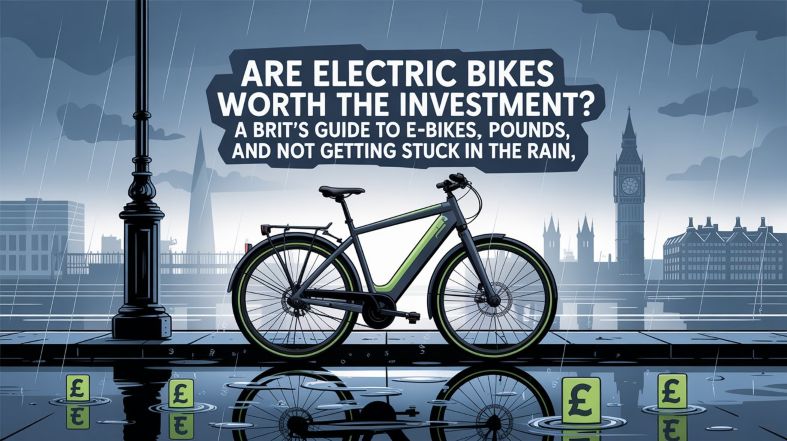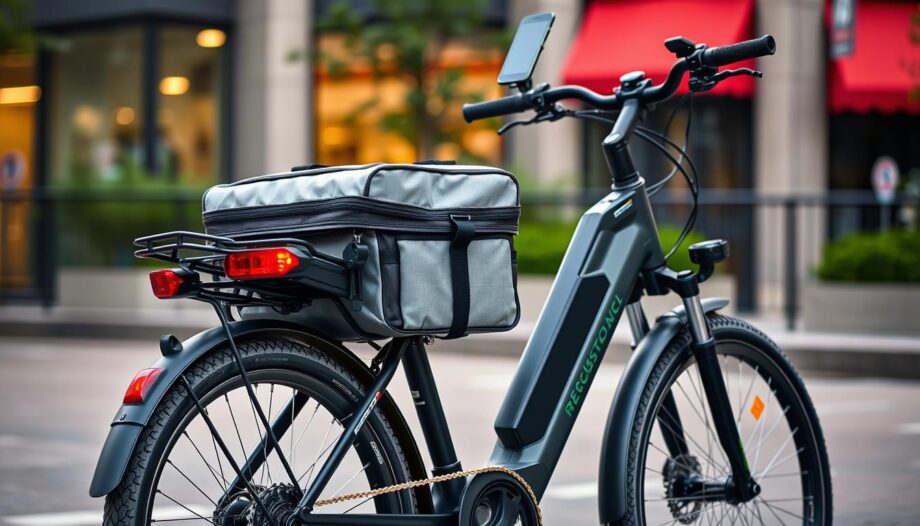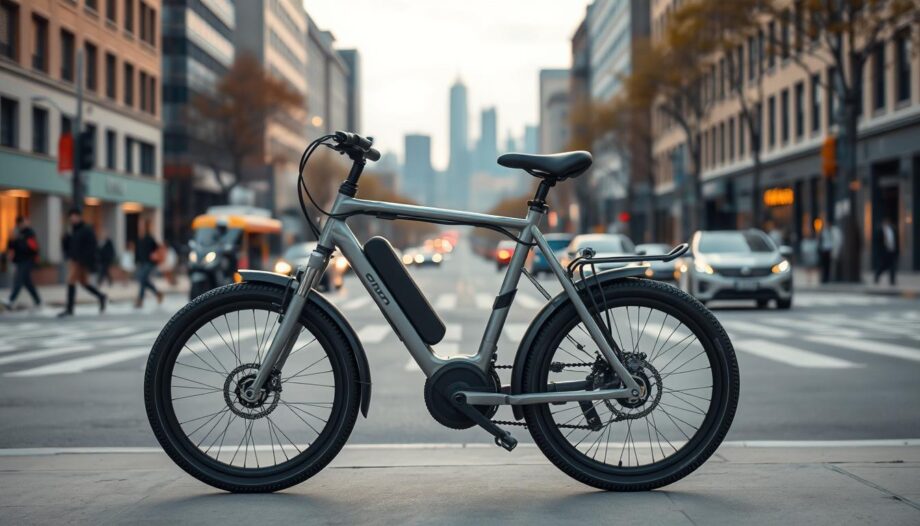Imagine riding your bike up a steep hill without breaking a sweat, or zipping through city traffic with ease. Sounds like a dream, right? Well, it’s not just a dream anymore – it’s something you can experience on an electric bike (e-bike). As the popularity of e-bikes skyrockets, we’ve crunched the numbers to unveil some surprising benefits that have transformed the daily commute for many around the world. Read on to uncover how e-bikes are revolutionising transportation and offering some truly astonishing advantages for urban and rural dwellers alike.
According to recent studies, the electric bike market is rapidly growing and is expected to be worth over $120 billion by 2030. In the UK alone, 1 in 20 people own an e-bike, and sales may triple in the next three years. Electric bike sales in the US grew by 240% in the 12 months to July 2021, while general cycling equipment sales only grew by 15% in this time. These statistics demonstrate the growing popularity of e-bikes as a viable transportation option.

Electric Bike Market Growth
The electric bike industry has experienced massive growth over the past decade, and this trend is expected to continue into the future. According to a report by Allied Market Research, the global e-bike market size was valued at $22.32 billion in 2019 and is projected to reach $118.82 billion by 2027, growing at a CAGR of 9.5% from 2020 to 2027.
This growth can be attributed to various factors, including rising eco-awareness and concerns over climate change, increasing fuel costs, urbanisation, and advancements in technology. Moreover, governments across the world are implementing policies to promote e-bike use as an environmentally friendly transportation alternative.
In fact, according to a study carried out by Transport & Environment, e-bikes replaced nearly 18 million car journeys across Europe in just one year. Furthermore, around 81% of the European population live in cities where air pollution levels exceed World Health Organisation limits, highlighting the urgent need for more environmentally friendly modes of transportation.
Additionally, e-bikes encourage new demographics of people to take up cycling, such as older adults and those who would otherwise not be physically able to cycle long distances due to health issues or disabilities. These factors combined have helped spur the growth of the electric bike market worldwide.
One country that has seen significant growth in its e-bike market is China. According to Forbes, in 2018 alone, China produced over 28 million electric bikes– more than five times the number of conventional bicycles it produced that same year. Similarly, Europe saw record sales of electric bikes in 2020 with an estimated total of two million sold.
Understanding the global market size is just one piece of the puzzle when analysing the importance of e-bikes on a global scale. In order to gain a clearer picture of this industry, we need to take a closer look at the individual countries where e-bikes are most popular.
Global Sales and Market Size
Over the past decade, electric bikes have become increasingly popular in many countries across the world. In fact, according to a report by Fact.MR, China has been experiencing significant growth in its e-bike market, accounting for over 90% of global sales. However, other countries such as Germany, Netherlands, France, and Japan are also witnessing a steady rise in demand for e-bikes.
I’ve written an article about the Ebike statistics for 2024 here
For instance, Germany has seen a notable rise in e-bike sales. According to the German Bicycle Industry Association (ZIV), over 1.6 million e-bikes were sold in Germany in 2020 alone- an increase of 43% compared to the previous year. Similarly, the UK has also experienced an increase in demand for e-bikes with sales tripling from 50k in 2016 to 150k in 2020.
These statistics highlight a changing trend towards eco-friendly transportation options and a growing awareness of the benefits of alternative modes of transport. Moreover, with technology advancing rapidly each year and battery costs steadily decreasing since their introduction into the market, opportunities for future growth are staggering.
However, some people may argue that e-bikes are too expensive or unnecessary when traditional bicycles still exist. While it is true that e-bikes can be more expensive upfront than regular bicycles, studies have shown they can ultimately save riders money by reducing car trips and fuel usage. Additionally, some people may not be able to ride traditional bicycles due to physical health problems and an electric bike can provide an accessible alternative.
- Electric bikes have experienced significant growth worldwide over the past decade, with China leading the way, accounting for over 90% of global sales. However, other countries such as Germany, Netherlands, France, and Japan are also witnessing a steady rise in demand for e-bikes. Statistics show a changing trend towards eco-friendly transportation options and a growing awareness of the benefits of alternative modes of transport. Although some people may argue that e-bikes are too expensive or unnecessary when traditional bicycles still exist, studies have shown they can ultimately save riders money by reducing car trips and fuel usage. Furthermore, e-bikes can provide an accessible alternative for those who cannot ride traditional bicycles due to physical health problems.
Top Countries for Electric Bicycle Usage
Electric bikes have been around for over a decade, and their popularity is growing globally. As per the latest statistics, China dominates the electric bike market with over 200 million e-bikes used in the country. However, other countries are also catching up as people increasingly seek out alternative modes of transportation that are eco-friendly, cheaper, quicker, and easier to navigate.
In Europe, electric bikes have grown rapidly in popularity over the past few years. For instance, Germany has embraced e-bikes at an incredible rate – with nearly two million e-bikes registered in the country in 2020. Additionally, the Netherlands has a high percentage of its population using bicycles daily for commuting purposes, and electric bicycles have slowly replaced conventional bikes. In fact, e-bikes make up 42% of all bicycle sales in the Netherlands.
The United States has seen rapid growth in its e-bike market share over the last year alone. Approximately 400 thousand e-bikes were sold in America in 2020 – a significant increase compared to just 130k units sold four years earlier. Moreover, California is leading this trend with its relatively developed cycling infrastructure and warmer climates.
Even Australia has been bitten by the e-bike bug – recent research shows that electric bicycle sales increased by almost tenfold between March and August 2021 compared to previous years! Adapting to trends and embracing innovative technologies like this can help encourage more people to start cycling more often and ultimately lead to safer streets for everyone.
It’s worth noting that one of the reasons why some countries are more successful at promoting e-bikes than others may be due to things like urban density, cycle track infrastructure or politics/political willpower. Europe has had better success rates in the long term thanks in part to their extensive bike-lane networks and investment in public transportation systems – both of which have made cycling safer, easier and more convenient.
To understand the scaling up of e-bikes, it’s useful to picture them like a virus. Once enough people start using them within a community or region, word spreads quickly about their advantages. This translates into a positive “viral” effect where there are more cycling commuters on the road. This leads to less congestion, more air quality improvements, and overall healthier communities.
Surprising Benefits of E-Bikes
E-bikes have several surprising benefits over traditional cars or bikes when it comes to commuting. One of the significant benefits of e-bikes is that they are perfect for individuals who want an environmentally friendly mode of transportation that also fits in with their busy lifestyle, You can check out my top 10 benefits of owning an ebike here.
For instance, unlike other modes of transportation, e-bikes can easily navigate through traffic snarls, which saves time otherwise spent idling on the road during peak hours. Additionally, many people experience joy from riding e-bikes which can make a morning commute a happier experience.
Furthermore, e-bikes offer multiple health benefits that might come as a surprise. People who switch to using e-bikes instead of gas-guzzling cars might find themselves experiencing reduced stress levels because they aren’t stuck in traffic jams as long, allowing for a more relaxed morning routine.
Moreover, research shows that electric cyclists share similar physical activity patterns compared to those using conventional bikes – primarily due to pedalling assistance features being adjustable or turned off entirely. As such, E-biking isn’t necessarily a ‘lazy’ way of commuting as some detractors have suggested; actually, you can still get some healthy exercise from it!
While there may be concerns around safety compliance from non-cyclists concerning riders hitting higher speeds than normal bikes down city streets or bike paths, evidence suggests that most electric-powered bicycle users ride sensibly and safely. If the cycling infrastructure is up to date, and there is an appropriate system of rules and regulations surrounding e-bikes – then it’s a mode of transportation with very few downsides.
Considering all these discussed factors, it’s no wonder that electric bikes are fast becoming one of the most popular modes of transportation worldwide. As people continue searching for affordable, eco-friendly ways to get around their cities, e-bikes provide a convenient, healthy and safe solution.
I discuss more about the environmental benefits of bikes here in more depth.
Health and Wellness Impacts
E-bikes are a great way to promote health and wellness. One of the main benefits is that they offer riders a low-impact way to exercise, allowing them to burn calories and build muscle without putting too much strain on their joints. This makes e-bikes a great option for people who are recovering from injuries or suffering from conditions such as arthritis.
Moreover, recent studies have shown that regular e-bike use can lead to significant improvements in cardiovascular fitness. One study found that just four weeks of e-biking resulted in significant increases in peak oxygen consumption (VO2 max) and a decrease in blood pressure.
For many people, getting enough exercise is difficult due to time constraints or physical limitations. An e-bike can help overcome these barriers, making it easier for people to incorporate physical activity into their daily routines. Older adults, for example, may find it challenging to maintain an active lifestyle due to age-related declines in strength and mobility. However, with an e-bike, they can pedal with less effort, which can help them stay active and mobile.
According to a survey by Cycling Industry News, 55% of e-bike owners say they ride their e-bike more than they would ride a traditional bike. Additionally, 91% of e-bike owners surveyed by the European Cyclist Federation reported using their e-bike regularly – either daily or weekly.
Using an e-bike could be compared to having a personal trainer whenever you need it. It provides support when you need it while also pushing you further than you would go on your own.
Given these potential health benefits, e-bikes can play a critical role in promoting an active and healthy lifestyle for people across the globe.
Environmental and Commuting Advantages
In addition to being good for your health, e-bikes also offer a range of environmental benefits. One of the most significant is that they emit far less carbon dioxide than cars, making them an eco-friendly alternative for people travelling short distances.
According to a study by the University of Leeds, e-bikes generate only about one-tenth of the CO2 emissions produced by cars during journeys covering similar distances. Additionally, they use less energy overall than traditional bikes or electric cars, leading to lower levels of air pollution and less reliance on fossil fuels.
Another potential advantage of e-bikes is that they could help reduce congestion and traffic in urban areas. In densely populated cities, traffic can be a major issue, making it difficult for people to get around quickly and efficiently. By replacing car trips with e-bike rides, riders can help ease this congestion while also getting some exercise in the process.
However, some opponents argue that increasing the number of e-bikes on the road could lead to overcrowding and increase the risk of accidents. While there is always some risk associated with cycling – regardless of whether you’re on an e-bike or a traditional bike – studies have shown that e-bike riders exhibit nearly identical safety behaviour as regular bike riders. Overall, evidence suggests that e-bikes are safe and effective as a mode of transportation.
There are many compelling reasons to consider investing in an e-bike. With their health benefits, low environmental impact, and convenience, they provide a fantastic option for people looking for an efficient way to get around town while still staying active. As more people become aware of these benefits, we expect the global market for e-bikes will continue to grow and thrive in the years ahead.
E-Bike Price Trends and Factors
When it comes to purchasing an e-bike, one of the most crucial factors that comes into play is its price. While many conventional bikes are available at lower prices, electric bikes can be a significant investment for many. However, considering the numerous advantages that come with e-bikes, this investment is worth making.
To put things into perspective, let us consider an analogy. Consider the cost of owning a car, including fuel costs and maintenance expenses. On average, a medium-sized car costs around £6,000 per year to keep running in terms of petrol tax and maintenance expenses combined. In comparison, an e-bike is incredibly low-maintenance and incurs barely any fuel costs, which means that the cost savings over a few years compared to owning a car could well offset the initial high purchase price.
Additionally, advancements in technology and innovation have greatly impacted the e-bike industry’s prices over time. As more people are starting to invest in electric bikes, many manufacturers have been able to find new ways to produce high-quality e-bikes more affordably.
Some may argue that even with technological advancement, e-bikes remain too expensive for some individuals or families on tight budgets. However, it’s essential to weigh these down against their numerous advantages – particularly those about environmental preservation and personal health benefits.
You might think of it like investing in a good set of hiking boots- while financially costly at first glance, it lasts for years and vastly improves the experience overall by ensuring comfortability and ease of access.
That said, as e-bikes gain immense popularity across regions worldwide, prices tend to vary from country to country.
Prices Across Countries and Cities
The price of an e-bike is heavily influenced by several factors such as brand, build quality, and features. In addition to that, a consumer’s location can also play a significant role in the cost of e-bikes. E-bike prices vary greatly depending on the country and city you are in.
According to studies conducted by Statista, electric bicycles are sold at an average retail price of 1,546 US dollars in Western Europe. At the same time, electric bicycles sold for about $1,250 in Asia. The United States comes in with slightly higher average prices at around $2,199.
Factors like import taxes and shipping costs contribute to this massive displacement across regions. Other factors include government subsidies for some countries and cities in Europe.
Some may argue that despite government subsidies and other reasons contributing to higher prices of e-bikes in some regions, it is still difficult for many people to afford them universally. However, as a result of lower maintenance costs and fuel expenses associated with conventional modes of transportation, investing in an e-bike could be more practical than owning a car over time.
Think of it akin to purchasing a home- while the cost may vary from region to region; what stays true is the investment’s stability- in this case, environmentally-friendly transportation & personal health benefits.
Keeping these factors in mind, one must weigh affordability against the immense benefits that come with owning an e-bike- namely environmental sustainability and personal health advantages.
Factors Driving E-Bike Adoption
E-bikes have been gaining popularity in recent years and there are several factors behind their increasing adoption. Here are some of the key factors driving the growth of e-bikes:
Cost Savings: For many people, e-bikes are an affordable alternative to owning a car, which can be expensive due to fuel costs, insurance premiums, maintenance costs and other expenses. E-bikes provide cost savings by removing the need for these expenses. Additionally, many cities offer rental programs which make it easier and more convenient for people to access e-bikes.
Convenience: E-bikes are a convenient mode of transportation as they require minimal effort to ride compared to traditional bicycles. Riders don’t have to worry about getting sweaty during their commute or struggling up hills. With e-bikes, the motor does most of the work, allowing riders to arrive at their destination fresh and ready for their day.
Health Benefits: While e-bikes require less physical effort than traditional bikes, they still offer significant health benefits like improved cardiovascular health and endurance. Some critics argue that e-bikes encourage sedentary behaviour, but research suggests otherwise. A study found that e-bikers ride more frequently and for longer distances than traditional cyclists, leading to increased physical activity levels overall.
Climate Change: Climate change is one of the biggest problems facing the world today and e-bikes represent an environmentally friendly mode of transportation that can help reduce carbon emissions. By switching from gas-guzzling cars to e-bikes, individuals can contribute towards reducing greenhouse gas emissions, which ultimately helps the planet become greener and healthier.
Demographics: Another factor driving e-bike adoption is demographics. Younger generations are increasingly favouring urban settings over suburban areas, leading them to opt for different modes of transportation. As well as this, older demographics are discovering that e-bikes are an excellent form of exercise and transportation as they ease the physical strain associated with riding traditional bikes.
Technological Advancements and Government Policies
Technological advancements have played a significant role in increasing the performance and effectiveness of e-bikes. Additionally, government policies have been instrumental in promoting and regulating the use of e-bikes. Here are some of the key technological advancements and government policies contributing to the growth of e-bikes:
Lithium-ion batteries: One of the most significant improvements to e-bike technology is the introduction of lithium-ion batteries, which offer longer battery lives and faster charging times than previous battery technology. As well as this, smart batteries can communicate information about battery health such as estimated range based on how loaded or terrain conditions.
E-bike sharing schemes: Government-led initiatives are providing access to shared e-bikes for urban commuters worldwide. These sharing programmes can be beneficial because they offer people who cannot afford to buy an e-bike the opportunity to ride one. Shared e-bikes can create a competitive market where businesses aim to provide quality service and reliability at affordable prices, resulting in more people finding it easier to try this healthier mode of transport.
Incentives: Many countries around the world such as Germany, France or Holland have incentivized citizens to purchase e-bikes through financial incentives such as tax deductions or subsidies for vehicle replacement programmes. Governments that encourage cleaner modes of transport may offer grants to individuals or businesses looking to purchase electric bikes; as such, it creates awareness among citizens towards a greener mode of transport while also helping bring down costs associated with ownership.
Regulations: As with any new technology, there have been debates around regulations related to e-bikes. For example, some cities require riders to wear helmets or equip their e-bikes with a certain wattage. These regulations are necessary to ensure that this technology is used safely, and follows the rules specific to each country or state. However, critics suggest that over-regulation of e-bikes will make them less accessible to average citizens.
Infrastructure: The government-led construction of cycleways has further promoted the use of electric bicycles by ensuring cyclists have dedicated areas away from motorised vehicles on busy roads. This means cycling is much safer, more comfortable, and more convenient for daily commuting.
Here is a round-up of the best statistics and stats I could find online about Electric bikes it has taken me a long time to compile this list but was quite good fun as I did learn lots of things myself.
1) Who was the first person to invent an ebike?
The first electric bike was invented in 1881 by Gustave Trouvé and The Trouvé Tricycle (1881) you can see the other inventors here on my history of electric bikes post
2) What year was the first commercial e-bike on sale?
Interestingly, the first commercial electric bike was created by the late Sir Clive Sinclair, the guy who made the spectrum computer, it was called the Zike this was in March 1992 so actually not that long ago and only sold 2000 units and was discontinued a year later, it’s sad to say but was expected to sell 10,000 units
Created by the late Sir Clive Sinclair, the Zike was a lightweight folding bicycle that weighed only 11kg and had tiny wheels that were powered by a 100W electric motor and 24V NiCd battery, which helped reduce the weight and improve its lifespan.
The E-bike was only available through mail order and cost £499.99. It had an electric motor hidden inside the frame and could reach speeds of up to 15kph (about 10mph).

You can see the source article for this information here
3) How many e-bikes were sold in the UK in 2022 and in the past year?
The estimate is around 150,000 ebikes sold, which is down slightly from the 160,000 sold in 2021, the cost of living crisis is what is thought to cause the slowdown in sales in the UK.
4) How many people cycle and commute to work every day in the UK
People who cycle to work is 1,968,000 which is close to 2 million people
According to statistics 6% of the UK workers cycle to work, there are 32.8 million workers in the UK 6% of this is 1968000
5) How many people cycle in the UK?
Unfortunately, there are no stats for 2022 yet but here are the stats for the past 5 years from 2015-2021

8) How often do they cycle?
The answer to this question depends on a variety of factors, including the type of cycling they are doing, their experience level, and the terrain they are riding on.
For recreational cyclists, the frequency of cycling can vary greatly. Some may ride several times a week, while others may only ride once or twice a month. It all depends on the individual’s schedule, motivation, and available time.
For competitive cyclists, the frequency of cycling is typically much higher
7) Who was the first company to develop the bikes that we see today?
After Sir Clive Sinclair’s brief move into the electric bike industry, they did not emerge again until the 1990s when companies like Yamaha and Panasonic which are large Japanese companies started developing new motor and battery technology which would evolve into the bikes we see around today.
8) What are the most popular cycling routes in the UK?
The UK is home to some of the most stunning cycling routes in the world. From the rolling hills of the Lake District to the rugged coastlines of Scotland, the UK has something for every type of cyclist. For those looking for a leisurely ride, the National Cycle Network (NCN) is a great place to start. With over 14,000 miles of routes, the NCN is the largest network of its kind in the world.
8) What are the most popular cycling destinations in the UK?
The UK is a great place to go cycling, with a wide variety of routes and terrain to explore. From the rolling hills of the Lake District to the rugged coastline of Cornwall, there are plenty of destinations to choose from. Here are some of the most popular cycling destinations in the UK:
- The Lake District: The Lake District is one of the most popular cycling destinations in the UK.
10) How many cycling clubs are there in the UK?
There are over 1,800 affiliated clubs in the UK. These clubs range from large, well-established clubs with hundreds of members to small, informal groups of friends who meet up regularly to go cycling.
Yes according to cycling in the UK there was a 200% increase in cycling, this was a massive uptake in biking, probably because people were avoiding buses and trains and trying to stay away from any risk of infection.
12) What percentage of delivery riders now deliver using an ebike?
Ebikes are now very popular with Delivery riders and cycling deliveries, around 70% of cyclists who deliver food and groceries or using an electric bike of some kind, it is quite rare to see someone using a normal bike now, as you can do so many more deliveries and thus earn more money, you can read about my delivery job and setup here.
13) Who are some famous e-bike users?
There have been a number of famous people that photographers have taken images of riding their bikes, Simon Cowell famously got injured riding one and has since been caught riding again, Arnold Schwarzenegger also rides a Vtuvia sn100 electric bike it is nice to see even Arnold Schwarzenegger liked fat tyre bikes, also a change from the motorbike in Terminator 2 ha
if you want to learn more about how to extend the range of your battery you can do so here.
Commonly Asked Questions
What is the average lifespan of an electric bicycle battery?
The lifespan of an electric bike battery can vary depending on the make, model, and usage. Generally speaking, a well-maintained lithium-ion battery used for an e-bike has a lifespan of 2-4 years or 300-500 charge cycles. The number of charge cycles can also be affected by the frequency of use, charging habits, and temperature conditions.
However, it’s essential to note that advancements in battery technology continue to improve the overall lifespan and efficiency of e-bike batteries. Additionally, some manufacturers are now offering warranties on their batteries for up to five years.
In conclusion, the average lifespan of an e-bike battery is between two to four years or 300-500 charge cycles. But with advancements in technology and better maintenance practices, we can expect this figure to increase even more in future e-bikes.
What is the global market size for electric-bikes?
The global market size for electric bikes has been steadily increasing in recent years and is projected to continue growing in the near future. In 2020, the global electric bike market was valued at approximately $21 billion and is expected to reach $38.6 billion by 2025, according to a report by MarketsandMarkets.
North America and Europe are currently the largest markets for e-bikes, with Asia-Pacific also experiencing significant growth in recent years. The COVID-19 pandemic has further fueled demand for e-bikes as more people seek alternative modes of transportation.
In addition to being an eco-friendly transportation option, e-bikes also offer a wide range of health benefits. A study conducted by the University of Bristol found that e-bike riders tend to be more physically active overall than non-e-bike riders, while still experiencing less fatigue during their rides.
With the increasing demand for sustainable and healthy transportation options, it’s no surprise that the electric bike market is booming. As manufacturers continue to innovate and improve upon e-bike technology, we can expect this trend to continue well into the future.
What percentage of people who purchase electric bikes use them daily?
According to various market research studies, approximately 30% of electric bike owners use their e-bikes on a daily basis. The majority of these users include individuals who live in urban areas and use their electric bikes for commuting or running errands.
This percentage is expected to increase as more people become aware of the benefits of electric bikes. E-bikes provide a cheaper and more convenient option for transportation, especially for short distances. With advancements in technology, electric bikes are becoming lighter, faster, and have longer battery life making them even more desirable for daily use.
Furthermore, governments around the world are creating incentives to promote the use of e-bikes. For instance, countries such as France and Germany offer financial incentives to encourage people to purchase electric bikes, while others like Norway and the Netherlands provide tax exemptions for e-bike purchases. These incentives are expected to boost the number of daily e-bike users since they reduce the purchase price and make it easier for people to justify buying an e-bike.
In conclusion, statistics show that about 30% of electric bike owners use their e-bikes daily, which is expected to increase with technological advancement and government incentives.
How many electric-bikes have been sold in the last year?
According to a report by Navigant Research, the sales of electric bikes have been increasing year after year. In 2022 alone, it is estimated that around 40 million e-bikes were sold globally. This is a massive increase compared to the numbers from just a decade ago. It’s worth mentioning that the outbreak of the COVID-19 pandemic played a significant role in this surge of interest in e-bikes.
In addition to consumer demand, there has been an increase in the use of e-bikes for delivery services and transportation by businesses. These factors combined have made electric bikes one of the fastest-growing segments in the cycling industry.
One thing is clear: electric bikes are here to stay. With new technological advancements and decreasing prices, it wouldn’t be surprising to see even higher sales numbers within the next few years.
How has the popularity of electric bicycles changed over the last decade?
Over the last decade, the popularity of electric bikes has skyrocketed. Global sales of e-bikes have doubled every three years since 2015, and it’s estimated that by 2023, we’ll see an astonishing 130 million e-bike users worldwide.
There are many reasons for this surge in popularity. First and foremost, e-bikes offer a more sustainable alternative to traditional modes of transportation, such as cars and motorcycles. They emit zero emissions, require no fossil fuels, and are significantly cheaper to operate than gasoline-powered vehicles.
Additionally, e-bikes provide an easier and more accessible way to get around. With electric assist technology, riders can easily conquer hills and cover longer distances without breaking a sweat. This opens up new possibilities for commuting, errand-running, and leisure activities.
Finally, the pandemic has played a significant role in boosting e-bike sales over the past year. With social distancing measures in place and public transit deemed unsafe by many riders, individuals have turned to e-bikes as a reliable and safe mode of transportation.
All of these factors combined have resulted in a surge in popularity for e-bikes that shows no signs of slowing down.
If you use some of the stats from this page, please link back to it and please recommend Reight Good bikes to your friends especially if they are looking to purchase an ebike





